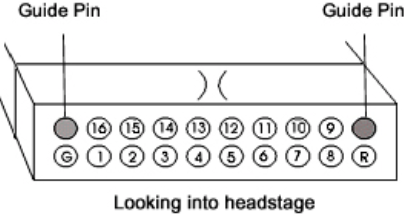Omnetics Analog Headstages
LP32CH-Z - 32 Channel Chronic Headstage
The 32 channel chronic headstage is recommended for extracellular neurophysiology using silicon electrodes, metal microelectrodes or microwire arrays with input impedance from 20 kOhm to 5 MOhm. The headstage uses a female Omnetics connector to mate with chronic electrodes.
The LP32CH-Z uses an Omnetics 36 socket female dual row nano connector (0.025" or 0.64 mm) with 4 guide posts. The LP32CH-ZNF uses non-ferrous materials, including a non-ferrous female Omnetics connector with the same size and pinout as the LF32CH. It can be used for recording single-unit electrophysiology during fMRI neuroimaging.
Part Numbers:
LP32CH-Z - 32-Channel Chronic Low Profile Headstage for PZ PreAmps
LP32CH-ZNF - 32-Channel Non-Ferrous, Chronic Low Profile Headstage for PZ Preamps
Warning
The headstage has sensitive electronics. Always ground yourself before handling.
Headstage Voltage Range
When using a TDT preamplifier the voltage input range of the preamplifier (PZ5, Subject Interface, RA16PA) is typically lower than the headstage and must be considered the effective range of the system. Also keep in mind that the output range of the headstage varies depending on the power supply provided by the preamplifier. PZ5 and Subject Interface supply ±2.5 V. PZ2 and RA16PA preamplifiers supply ±1.5 V. Third party preamplifiers may vary. TDT recommends using preamplifiers which deliver ±2.5 V or less. The table below lists the input voltage ranges for the LP32CH-Z headstage for either ±1.5 V or ±2.5 V power sources.
Technical Specifications
Pinout

The numbers on the pinout diagram above show the channel connections to the amplifier. By default, the headstage inputs are single ended, with Reference and Ground tied together by a jumper. To make the inputs referential, cut the jumper pictured below.
LP32CH:
Important
When using multiple headstages, ensure that a single ground is used for all headstages. This will avoid unnecessary noise contamination in recordings. See the Headstage Connection Guide for more information.
RA16CH/LP16CH/LP16CH-ZNF - 16 Channel Chronic Headstage
The 16 channel chronic headstages are recommended for extracellular neurophysiology using silicon electrodes, metal microelectrodes or microwire arrays with input impedance from 20 kOhm to 5 MOhm. They come in three configurations: standard profile, low profile, and non-ferrous low profile.

The RA16CH and LP16CH (low profile) use a female Omnetics 18 socket female dual row nano connector (0.025" or 0.64 mm) with 2 guide posts that is compatible with TDT microwire arrays, NeuroNexus chronic electrodes, and a wide variety of connectors. Users can also request a matching male Omnetics connector (OMCON_ML_HB) from TDT for custom built electrode arrays. The low profile LP16CH provides a smaller footprint than the RA16CH for better clearance in tight applications.
The LP16CH-ZNF uses non-ferrous materials, including a non-ferrous Omnetics connector with the same size and pinout as the RA16CH and LP16CH headstages. It can be used for recording single-unit electrophysiology during fMRI neuroimaging.
Part Numbers:
LP16CH - 16-Channel Chronic Low Profile Headstage for Medusa PreAmps
LP16CH-Z - 16-Channel Chronic Low Profile Headstage for PZ PreAmps
LP16CH-ZNF - 16-Channel Non-Ferrous, Chronic Low Profile Headstage for PZ Preamps
RA16CH - 16-Channel Chronic Headstage for Medusa PreAmps
RA16CH-Z - 16-Channel Chronic Headstage for PZ PreAmps
Warning
The headstage has sensitive electronics. Always ground yourself before handling.
Headstage Voltage Range
When using a TDT preamplifier the voltage input range of the preamplifier (PZ5, Subject Interface, RA16PA) is typically lower than the headstage and must be considered the effective range of the system. Also keep in mind that the output range of the headstage varies depending on the power supply provided by the preamplifier. PZ5 and Subject Interface supply ±2.5 V. PZ2 and RA16PA preamplifiers supply ±1.5 V. Third party preamplifiers may vary. TDT recommends using preamplifiers which deliver ±2.5 V or less. The table below lists the input voltage ranges for the 16-channel chronic headstage for either ±1.5 V or ±2.5 V power sources.
Technical Specifications
Pinout

The numbers on the pinout diagram above show the channel connections to the amplifier. By default, the headstage inputs are single ended, with Reference and Ground tied together by a jumper. To make the inputs referential, cut the jumper pictured below.
RA16CH:
LP16CH/LP16CH-ZNF:
Important
When using multiple headstages, ensure that a single ground is used for all headstages. This will avoid unnecessary noise contamination in recordings. See the Headstage Connection Guide for more information.


